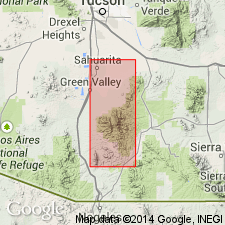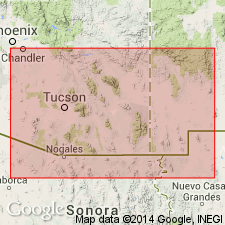
- Usage in publication:
-
- Salero Formation*
- Modifications:
-
- Named
- Geochronologic dating
- Dominant lithology:
-
- Dacite
- Rhyodacite
- Arkose
- Tuff
- AAPG geologic province:
-
- Basin-and-Range province
Summary:
Named for Salero Ranch and Mine in Santa Rita Mountains, Mount Wrightson quad, Santa Cruz Co, AZ. The ranch and mine are the type area. Crops out in southwest and north end, Santa Rita Mountains. Contains a lower member of dacitic flows and tuff breccia, an exotic block member that contains large blocks (some as much as 1,000 ft long) of Jurassic and older rocks in a volcanic flow breccia, a rhyodacitic welded tuff member, an arkose member of arkosic fanglomerate, conglomerate, sandstone, and tuff, and an upper member of mixed volcanic and sedimentary rocks--tuffaceous sandstone, tuff breccia, agglomerate, conglomerate, quartzite. Biotite from welded tuff member has K-Ar age of 72.5 +/-2.2 Ma. The formation has a composite maximum thickness of about 5,000 ft. Conformably overlies the Fort Crittenden Formation, or on Squaw Gulch Granite [See Note Below]. Is intruded by plutons of latest Cretaceous age. Is assigned to the Late Cretaceous. Biotite from welded tuff has 72.5 +/-2.2 m.y. K-Ar method.
[NOTE: In accordance with Department of Interior's Secretarial Order 3404, discontinuing use of derogatory term squaw, the Squaw Gulch Granite is in process of being formally renamed Santa Rita Gulch Granite (RESERVED). The geographic feature Squaw Gulch, from which the geologic name was taken (this report), was renamed Santa Rita Gulch by U.S. Board on Geographic Names, September 2022, USGS GNIS FeatureID 638662.]
Source: GNU records (USGS DDS-6; Denver GNULEX).

- Usage in publication:
-
- Salero Formation*
- Modifications:
-
- Overview
- AAPG geologic province:
-
- Basin-and-Range province
Summary:
Is youngest Cretaceous formation in Santa Rita Mountains (Santa Cruz and Pima Cos, AZ) and Empire Mountains (Pima Co, AZ) in Basin-and-Range province. No Upper Cretaceous rocks recognized in Whetstone Mountains. Overlies Fort Crittenden Formation (Campanian) conformably locally on west side of Santa Rita Mountains; elsewhere in range, conformably overlies Jurassic granite. Overlies rocks of Bisbee Group (Lower Cretaceous) unconformably in Empire Mountains. Is intruded by rocks dated as very Late Cretaceous; is overlain by a variety of rocks assigned to Tertiary or Quaternary. Is as much as 5,000 ft thick in Santa Rita and Empire Mountains. Lower part is considered at least approximately correlative with numerous andesitic rocks in region (see fig. 5). Rhyolitic tuffs of Salero are considered correlative with numerous rhyolitic tuffs in region (fig. 5). Units comparable to upper part of Salero in Santa Rita Mountains have not been identified elsewhere in region. Radiometric dating (Gill and Cobban, 1966) and stratigraphic position dating indicates probable late Campanian and possibly earliest Maestrichtian age.
Source: GNU records (USGS DDS-6; Denver GNULEX).
For more information, please contact Nancy Stamm, Geologic Names Committee Secretary.
Asterisk (*) indicates published by U.S. Geological Survey authors.
"No current usage" (†) implies that a name has been abandoned or has fallen into disuse. Former usage and, if known, replacement name given in parentheses ( ).
Slash (/) indicates name conflicts with nomenclatural guidelines (CSN, 1933; ACSN, 1961, 1970; NACSN, 1983, 2005, 2021). May be explained within brackets ([ ]).

